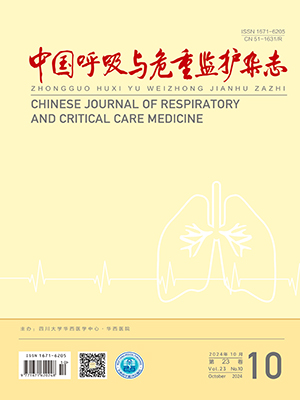| 1. |
GOLD Executive Committee. Global Initiative for Chronic Obstructive Lung Disease. Global Strategy for the Diagnosis, Management, and Prevention of Chronic Obstructive Pulmonary Disease 2020 Report [EB/OL]. [2019-11-14].https://goldcopd.org.
|
| 2. |
Wang C, Xu J, Yang L, et al. Prevalence and risk factors of chronic obstructive pulmonary disease in China (the China Pulmonary Health study): a national cross-sectional study. Lancet, 2018, 391(10131): 1706-1717.
|
| 3. |
Molimard M, Raherison C, Lignot S, et al. Chronic obstructive pulmonary disease exacerbation and inhaler device handling: real-life assessment of 2935 patients. Eur Respir J, 2017, 49(2): 1601794.
|
| 4. |
Kneussl M, Kummer F. Role of the parasympathetic system in airway obstruction due to emphysema. N Engl J Med, 1984, 311(21): 1379-1380.
|
| 5. |
Bucher H, Duechs MJ, Tilp C, et al. Tiotropium attenuates virus-induced pulmonary inflammation in cigarette smoke-exposed mice. J Pharmacol Exp Ther, 2016, 357(3): 606-618.
|
| 6. |
Hsiao Y, Tseng C, Su K, et al. Glycopyrronium bromide inhibits lung inflammation and small airway remodeling induced by subchronic cigarette smoke exposure in mice. Respir Physiol Neurobiol, 2018, 249: 16-22.
|
| 7. |
Kistemaker LE, Slebos DJ, Meurs H, et al. Anti-inflammatory effects of targeted lung denervation in patients with COPD. Eur Respir J, 2015, 46(5): 1489-1492.
|
| 8. |
Aziz M, Tan LE, Wu DB, et al. Comparative efficacy of inhaled medications (ICS/LABA, LAMA, LAMA/LABA and SAMA) for COPD: a systematic review and network meta-analysis. Int J Chron Obstruct Pulmon Dis, 2018, 13: 3203-3231.
|
| 9. |
Hummel JP, Mayse ML, Dimmer S, et al. Physiologic and histopathologic effects of targeted lung denervation in an animal model. J Appl Physiol (1985), 2019, 126(1): 67-76.
|
| 10. |
Slebos DJ, Klooster K, Koegelenberg CF, et al. Targeted lung denervation for moderate to severe COPD: a pilot study. Thorax, 2015, 70(5): 411-419.
|
| 11. |
Valipour A, Asadi S, Pison C, et al. Long-term safety of bilateral targeted lung denervation in patients with COPD. Int J Chron Obstruct Pulmon Dis, 2018, 13: 2163-2172.
|
| 12. |
Valipour A, Shah PL, Pison C, et al. Safety and dose study of targeted lung denervation in moderate/severe COPD patients. Respiration, 2019, 98(4): 329-339.
|
| 13. |
Slebos DJ, Shah PL, Herth F, et al. Safety and adverse events after targeted lung denervation for symptomatic moderate to severe chronic obstructive pulmonary disease (AIRFLOW). A multicenter randomized controlled clinical trial. Am J Respir Crit Care Med, 2019, 200(12): 1477-1486.
|
| 14. |
Pison C, Shah PL, Slebos DJ, et al. Safety of denervation following targeted lung denervation therapy for COPD: AIRFLOW-1 3 -year outcomes. Respir Res, 2021, 22(1): 62.
|
| 15. |
Valipour A, Shah PL, Herth FJ, et al. Two-Year Outcomes for the Double-Blind, Randomized, Sham-Controlled Study of Targeted Lung Denervation in Patients with Moderate to Severe COPD: AIRFLOW-2. Int J Chron Obstruct Pulmon Dis, 2020, 15: 2807-2816.
|
| 16. |
Slebos DJ, Degano B, Valipour A, et al. Design for a multicenter, randomized, sham-controlled study to evaluate safety and efficacy after treatment with the Nuvaira® lung denervation system in subjects with chronic obstructive pulmonary disease (AIRFLOW-3). BMC Pulm Med, 2020, 20(1): 41.
|
| 17. |
Koegelenberg CF, Theron J, Slebos DJ, et al. Antimuscarinic bronchodilator response retained after bronchoscopic vagal denervation in chronic obstructive pulmonary disease patients. Respiration, 2016, 92(1): 58-60.
|
| 18. |
Gosens R, Zaagsma J, Meurs H, et al. Muscarinic receptor signaling in the pathophysiology of asthma and COPD. Respir Res, 2006, 7: 73.
|
| 19. |
Milara J, Cervera A, de Diego A, et al. Non-neuronal cholinergic system contributes to corticosteroid resistance in chronic obstructive pulmonary disease patients. Respir Res, 2016, 17(1): 145.
|




